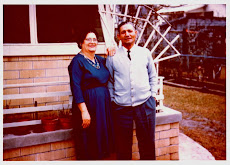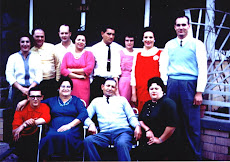Photo: The family gathered outside 1804 East Howard Avenue, 1963. Front row from left: Uncle Michael Soljan, Nona (Mary Rosetti Soljan), Grandpa (Mato "Mike" Soljan), Aunt Marie (Soljan Sullivan). Back row from left: Mama (Antonia "Toni" Soljan Willis), Daddy (Jerry Willis), Uncle Steve (West), Aunt Dolores (Soljan West), Uncle Raymond (Soljan), Aunt Peggy (Gore Soljan), Aunt Selema (Soljan Castle), Uncle Russ (Castle).
Nona and Grandpa's house on East Howard was a simple 1940s wood frame and brick bungalow, fairly typical for the neighborhood, but it was the most wonderful place in the world to me.
When we camped out in the darkened living room to watch TV, the lamp, shaped like a covered wagon with a team of horses galloping across the the top of the TV set, cast a reassuring ruddy glow.
From opposite corners of the room, studio portraits of my Aunt Marie and Uncle Michael -- she in a teased bouffant with spit curls and a black velvet shoulder drape, he in studious horn rims and graduation cap and gown -- smiled down like beatific angels. The living room furniture was always draped with crocheted afghans, sheets and other fabric to protect it from daily use, except on holidays and other "good" occasions when company was expected.
The dining room was full even when empty of food. The sideboard was taken up by exotic Oriental figure vases and decanters brimming with green colored water -- a decorating fad that no one seemed to realize had become passe. The wall next to the kitchen door was dominated by grandchildren's photos arranged like a family tree. I think the grandparents needed it to keep track of which kid belonged to whom. The corner built-ins burst with cut glass, candy dishes figurines and souvenirs from Alaska, Germany and Bellingham Washington.
When we camped out in the darkened living room to watch TV, the lamp, shaped like a covered wagon with a team of horses galloping across the the top of the TV set, cast a reassuring ruddy glow.
From opposite corners of the room, studio portraits of my Aunt Marie and Uncle Michael -- she in a teased bouffant with spit curls and a black velvet shoulder drape, he in studious horn rims and graduation cap and gown -- smiled down like beatific angels. The living room furniture was always draped with crocheted afghans, sheets and other fabric to protect it from daily use, except on holidays and other "good" occasions when company was expected.
The dining room was full even when empty of food. The sideboard was taken up by exotic Oriental figure vases and decanters brimming with green colored water -- a decorating fad that no one seemed to realize had become passe. The wall next to the kitchen door was dominated by grandchildren's photos arranged like a family tree. I think the grandparents needed it to keep track of which kid belonged to whom. The corner built-ins burst with cut glass, candy dishes figurines and souvenirs from Alaska, Germany and Bellingham Washington.

The siblings gather in the dining room. This photo was taken sometime after Camille, probably in the mid 1970s. Seated: Uncle Raymond and Aunt Dolores. Standing from left: Uncle Michael, Aunt Selema, Aunt Marie and Mama.
On frosty winter nights, nothing felt better than coming in out of wind and standing on the floor furnace grate until our stockinged soles couldn't take it anymore.
A popular kid hang-out was the front guest room with its "good" lavender flowered bed spread that we grandchildren sat on at the risk of getting our guzicas (pronounced guh zitz ahs) beaten. I swear Nona could hear a squeaky bed spring from around the block.
One couldn't help but feel safe from every possible bogeyman when sleeping in that house. Crucifixes hung in every bedroom; dried palm fronds and prayer cards were tucked into the edges of bureau mirrors (the tops were always dressed with frilly hand-made doilies); jars of holy water rested on every bedside table.
For extra insurance, a framed dime store print of the Guardian Angel oversaw our slumbers, just as did in every bedroom on the Point.
The guest bedroom had a cedar chest filled with sheets, embroidered pillow cases and, lacy frilled doilies -- all starched, ironed and neatly folded for the next use.
The well-worn, soft, pilled flannel shirts in Grandpa's closet were redolent of tobacco and Old Spice cologne. At least he wore the dime store cologne we dutifully delivered as dual Christmas/birthday presents each December. On Nona's bureau, a collection of barely used Avon bottles jockied for space with the cheap plastic religious figurines that we sold for parochial school fundraisers.
As in any Point home, the kitchen was the heart of Mike and Mary's with its Barq's bottle opener mounted to the wall, the lingering smells of drip coffee and grilled "boat bread" from breakfast and always a pot of soup, beans, daube or pasta i fazol on the stove, the multi-colored aluminum pitcher and tumbler set (although I confess I did not love the iced tea Nona served in it), and the slightly dented aluminum cake stand cover that usually contained a pound cake.
For extra insurance, a framed dime store print of the Guardian Angel oversaw our slumbers, just as did in every bedroom on the Point.
The guest bedroom had a cedar chest filled with sheets, embroidered pillow cases and, lacy frilled doilies -- all starched, ironed and neatly folded for the next use.
The well-worn, soft, pilled flannel shirts in Grandpa's closet were redolent of tobacco and Old Spice cologne. At least he wore the dime store cologne we dutifully delivered as dual Christmas/birthday presents each December. On Nona's bureau, a collection of barely used Avon bottles jockied for space with the cheap plastic religious figurines that we sold for parochial school fundraisers.
As in any Point home, the kitchen was the heart of Mike and Mary's with its Barq's bottle opener mounted to the wall, the lingering smells of drip coffee and grilled "boat bread" from breakfast and always a pot of soup, beans, daube or pasta i fazol on the stove, the multi-colored aluminum pitcher and tumbler set (although I confess I did not love the iced tea Nona served in it), and the slightly dented aluminum cake stand cover that usually contained a pound cake.
The screened porch was a great place to visit or people watch when we weren't walking on the old fishing bridge (but only as far as our mamas could see us from the house). We all fought over the gliders. The yard though small provided wonderful spots to play hide and seek. My cousin Joey could camouflage a team of five kids in that tiny yard so well that even their mamas would have a hard time finding them. Nona loved flowers and always kept her plant beds in beautiful condition.
Hurricane Camille took out much of what I loved in the original house -- which itself was a replacement for the house lost there in the Hurricane of 1947 -- but the somehow the portraits of Aunt Marie and Uncle Michael were still hanging in their corners; waves had crashed through the house, ruining everything else.
After my grandparents passed, Aunt Marie lived in the house for a while, then sold the property to a retired Catholic priest who bought it for himself, his mother and sister recently come from Vietnam to live in. Occasionally, my mother and aunts would stop by the old place to say hello.
Every morning when Father said Mass, he included blessings for all of us -- the many generations of Soljans sheltered and nourished for so many years in that kitchen in the little house at 1804 East Howard Avenue.
Beef and Baby Pasta Soup
I can't think of my grandparents' kitchen without thinking of soup, juha in Croatian. Beef soup with baby pastina was a favorite, especially when served with a heaping side plate of sauerkraut, boiled potatoes and mustard, pickled onions and sweet gherkins. Nona always made this with large piece of bone-in chuck. I find that beef today just doesn't taste as "beefy" as it used to and doesn't make a good beefy broth. If you find your cheaper cut of meat just ain't making the broth, substitute canned beef broth for some or all of the water in the recipe. When I made this after Christmas with the remnants of a standing holiday rib roast (with the bones still in), the soup tasted similar to what I remember. But I don't recommend buying a rib roast just to make the soup (unless your name is Rockefeller).
2-3 stalks of celery, diced
Beef and Baby Pasta Soup
I can't think of my grandparents' kitchen without thinking of soup, juha in Croatian. Beef soup with baby pastina was a favorite, especially when served with a heaping side plate of sauerkraut, boiled potatoes and mustard, pickled onions and sweet gherkins. Nona always made this with large piece of bone-in chuck. I find that beef today just doesn't taste as "beefy" as it used to and doesn't make a good beefy broth. If you find your cheaper cut of meat just ain't making the broth, substitute canned beef broth for some or all of the water in the recipe. When I made this after Christmas with the remnants of a standing holiday rib roast (with the bones still in), the soup tasted similar to what I remember. But I don't recommend buying a rib roast just to make the soup (unless your name is Rockefeller).
2-3 stalks of celery, diced
1 large onion, peeled and diced
3-4 potatoes, cut in large-ish chunks (you may one to dice one, but you want the chunks to dip into the mustard later)
3 -4 carrots, peeled and diced
1 large can whole tomatoes
2 1/2 quarts of cold water or canned beef broth.
Approx. 8-oz package of small pasta (I like the baby pastina beads, but use whatever type of pasta you like).
Place meat and water and broth in a large soup pot. Add salt to taste (about 1 tablespoon). let come to a boil. Skim off foam and boil until the meat stops foaming. Add celery, onions, potatoes, carrots and tomatoes. Boil until meat is tender. Remove meat. Add pasta. Cook until pasta is tender.
Approx. 8-oz package of small pasta (I like the baby pastina beads, but use whatever type of pasta you like).
Place meat and water and broth in a large soup pot. Add salt to taste (about 1 tablespoon). let come to a boil. Skim off foam and boil until the meat stops foaming. Add celery, onions, potatoes, carrots and tomatoes. Boil until meat is tender. Remove meat. Add pasta. Cook until pasta is tender.


